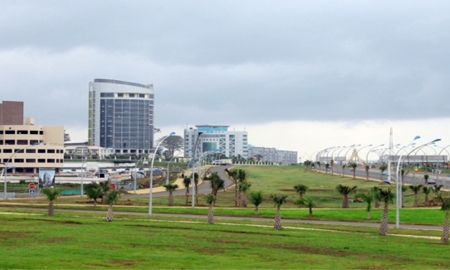In recent years economic growth, boosted by fossil fuel production, has transformed Equatorial Guinea into one of the richest countries in Africa. A significant share of the revenues from oil and gas production is currently being invested by the government in the creation of infrastructures vital to the country’s advancement. As a result, the infrastructure sector is expected to grow by over 3.2% in 2012 alone.
A dramatic transformation of the country’s economic and physical landscape is under way. The 2020 Economic and Social Development Plan is the government’s road map to creating a modern, diversified economy that can attract foreign investors, focusing not only on the existing primary sector, but also on developing sectors like electricity, tourism, light industry, banking, or the service industries.
The Plan includes over 1,500 infrastructure projects, including the creation of whole cities like Djibloho, the country’s new capital in the Wele-Nzas province, the recently inaugurated tourist coastal zone of Sipopo or the cities of Malabo 2 and Malabo 3. There are also ambitious engineering projects under way, like the Djibloho hydroelectric plant on the Wele River, and stadiums and hotels inaugurated during this year’s Africa Cup of Nations that Equatorial Guinea co-hosted with Gabon.
The government is placing a strong emphasis on opening both the mainland and the islands to international trade and tourism
The port of Luba has become a major transportation hub for offshore oil and gas companies operating in the Gulf of Guinea
|
According to the Ministry of Public Works and Infrastructure, Equatorial Guinea aims to become an emerging economy, a goal that presents a constant challenge. Therefore, everything the Ministry undertakes is targeted at favoring rapid development. This is why, for example, the government places such strong emphasis on opening both the mainland and the islands to international trade and tourism. Transport is key, and the government has already invested in the creation of new airports in Malabo, Bata and Annobon Island. The most symbolic project is Corisco Island’s airport: its 3,000-meter runway is particularly impressive.
But the Atlantic seaports are what attract most attention from companies worldwide. Equatorial Guinea has two of the deepest Atlantic seaports of the region, including the main business and commercial port city of Bata. The ever-increasing level of activity has meant that both Bata and Malabo have been severely overextended and are undergoing major reconstruction and expansion as a result, with Malabo set to become a maritime regional hub for ships traveling to and from South Africa, South America, and Europe.
The port of Luba has become a major transportation hub for offshore oil and gas companies operating in the Gulf of Guinea. According to the Ministry, all facilities the government creates – both public and private – are for the people of Equatorial Guinea, and the airport and the port in Annabon are excellent examples of this.
Ports chief Alberto Ndong Obiang Lima considers that all these projects will guarantee that Equatorial Guinea will become a key player in the shipping and import-export sectors, a guarantee that the economy will remain strong and continue to grow, even as the nation’s oil reserves become less significant. And he adds, “Many foreigners say that Equatorial Guinea is becoming Central Africa’s Dubai. I believe that this is true. We need only look at the investment and construction that is taking place here.”
The government has invested heavily in roads and highways. All of them require lighting, signalling and maintenance – contracts which have drawn the interest of Chinese, French and Lebanese companies, though there is still a whole host of contracts to be won.
There are also many opportunities for architectural studios and construction companies, in both the public and private sector. Apartments, government buildings, social housing, hotels, office buildings, factories and entire new cities are being created in areas newly destined for urban or tourism development. Both Malabo 2 and Malabo 3 are being sculpted from the jungle.
Due to the sheer amount of construction underway, the demand for basic construction materials and manpower is high, and cannot be met locally. Therefore, Equatorial Guinea is seeking international partners to help provide both industrial expertise and qualified workers. It is important for foreign countries to take into consideration the entrance costs, and the fact that there are companies with a long track record in the country, such as
Somagec or Bouygues.
Most homes and businesses still have no access to running water, electricity or sewage and garbage disposal systems, so there is still a raft of business opportunities to be had in the midst of this unprecedented construction boom in Central Africa’s richest country. And many more are yet to come as the government consolidates its vision of creating a modern and dynamic country ready to embrace its future.

0 COMMENTS